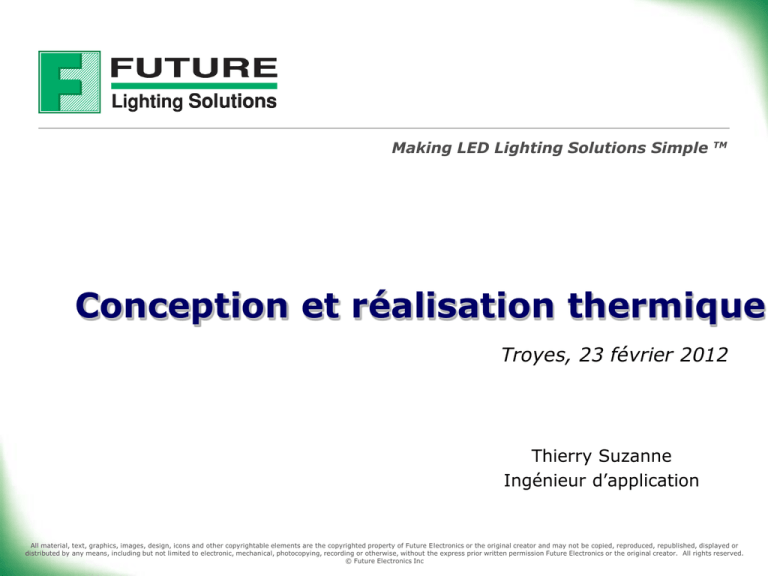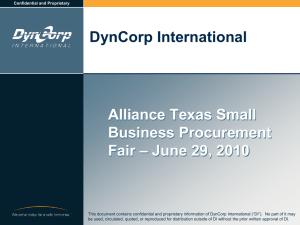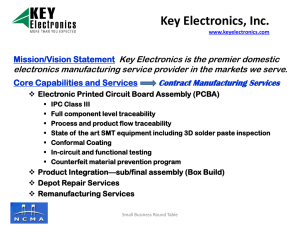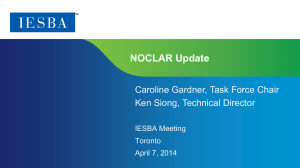
Making LED Lighting Solutions Simple
TM
Conception et réalisation thermique
Troyes, 23 février 2012
Thierry Suzanne
Ingénieur d’application
All material, text, graphics, images, design, icons and other copyrightable elements are the copyrighted property of Future Electronics or the original creator and may not be copied, reproduced, republished, displayed or
distributed by any means, including but not limited to electronic, mechanical, photocopying, recording or otherwise, without the express prior written permission Future Electronics or the original creator. All rights reserved.
© Future Electronics Inc
Designer’s Complaint…
• LEDs are specified @ single test current @ 25°C Tj
• My application is different!
• What is the real light output for my application?
© Future Electronics Inc.
Confidential and Proprietary
Making LED Lighting Solutions Simple
TM
LED Datasheet Specifications
• A new trend in the data- sheet characterization of
the LEDs
–
The LEDs are tested and binned at real world
operating conditions
Hot Binning @ 85oC
© Future Electronics Inc.
Confidential and Proprietary
Making LED Lighting Solutions Simple
TM
What is LED Junction Temperature
• Temperature directly on the LED chip/die
LED Junction Temperature (Tj)
• What does tested and binned at 25oC or 85oC at a
specific drive current of for example 700mA mean?
– The LED was driven at 700mA and light output measurements were
made while the junction temperature at the LED was maintained at 85oC
© Future Electronics Inc.
Confidential and Proprietary
Making LED Lighting Solutions Simple
TM
Measurement Point
• Application Brief AB33
http://www.philipslumileds.com/uploads/10/A
B33-pdf
© Future Electronics Inc.
Confidential and Proprietary
Making LED Lighting Solutions Simple
TM
Heat Generation
• LEDs are not 100% efficient
power consumed is not
completely converted to light
• Approximately, 30% to 50 %
(depending on the
technology) is converted to
light and the rest is
converted to heat
© Future Electronics Inc.
Confidential and Proprietary
Heat
Radiometric Power (power
converted to light)
Making LED Lighting Solutions Simple
TM
Heat Flow
• No heat in LED’s main light beam
• Heat generated by the LED is dissipated via the
thermal pad underneath the LED
• LED thermal pad does not provide enough surface to
dissipate the heat
• We add board, thermally conductive material and heat
sink to transfer the heat from the LED junction to the
air surrounding the LED
No heat in the
light beam
Thermal Pad
© Future Electronics Inc.
Confidential and Proprietary
Making LED Lighting Solutions Simple
TM
Effects of Heat on LEDs
• Heat affects the LEDs in 5 different
ways:
–
–
–
–
–
Light output
Color shift
Forward voltage shift
LED lifetime
Permanent damage
© Future Electronics Inc.
Confidential and Proprietary
Making LED Lighting Solutions Simple
TM
Effects of Heat on LEDs
Reduces Light Output
200%
Relative Light Output (LOP)
Red
Amber
Royal Blue
Blue
Green
Cyan
150%
White
100%
90%
100% light output at 25oC
50%
0%
-40
-20
0
20
40
60 70C
80
100
120
Junction Temperature TJ [°C]
• AlInGaP: Red, Red-Orange, Amber
More sensitive to heat
• InGaN: Royal-Blue, Blue, Green, Cyan, White
© Future Electronics Inc.
Confidential and Proprietary
Making LED Lighting Solutions Simple
TM
Effects of Heat on LEDs
Shifts dominant wavelength
Color
K
(nm/ºC)
Amber
.09
© Future Electronics Inc.
Confidential and Proprietary
Red
.03
Blue
.04
Green
.04
Cyan
.04
*
Making LED Lighting Solutions Simple
TM
Effects of Heat on LEDs
Tj
Vf
Forward Current (mA)
400
350
LED Driver: Vout= 43-48V
Royal Blue, Blue, Cyan,
300
250
@ 25oC Vf=3.0V
Green, White (InGaN)
15 LEDs:
Red, Reddish Orange,
200
→ 15 x 3.0 = 45V
Amber(AlInGaP)
OK!!
150
@ 87oC Vf=2.85V
100
50
0
Vf -2.0 to -4.0mV/°C
0.0
0.5
1.0
1.5
2.0
2.5
3.0
3.5
15 LEDs:
4.0
Forward Voltage (V)
© Future Electronics Inc.
Confidential and Proprietary
→ 15 x 2.85 = 42.75V
Not OK!!
Making LED Lighting Solutions Simple
TM
Effects of Heat on LEDs
(B50, L70)
What is (B50, L70)?
© Future Electronics Inc.
Confidential and Proprietary
Making LED Lighting Solutions Simple
TM
Lumen Maintenance - (Bxx,
Lyy)
• Notation used to describe the average lumen
maintenance characteristic of the LEDs.
• Lumen maintenance for SSL devices is typically defined
in terms of the percentage of initial light output
remaining after a specific period of time.
• (Bxx, Lyy)
– Bxx: percentage of LEDs, on average
– Lyy: percentage of light output remaining
• Example – (B50, L70) at 50000hours:
– On average, the light output of 50% (B50) of the LEDs
within the system will drop to lower than 70% (L70) of
their initial light output after 50000hours.
© Future Electronics Inc.
Confidential and Proprietary
Making LED Lighting Solutions Simple
TM
Effects of Heat on LEDs
Reduces operating life
~50.0%
(B50, L70)
© Future Electronics Inc.
Confidential and Proprietary
Making LED Lighting Solutions Simple
~155k
~175k
~165k
TM
Effects of Heat on LEDs
May cause severe damage
Thermal management is critical
© Future Electronics Inc.
Confidential and Proprietary
Making LED Lighting Solutions Simple
TM
Basic cooling considerations
• Conduction:
– The transfer of heat
energy through a
substance or from one
substance to another due
to temperature difference
Convection
• Convection:
– The process in which hot air
rises and cool air delves down.
Hot air will cool down as it
flows through the cooler air
mass until it reaches
equilibrium.
Conduction
Radiation
• Radiation:
– The transfer of heat via
electromagnetic waves
through space
© Future Electronics Inc.
Confidential and Proprietary
Making LED Lighting Solutions Simple
TM
Thermal Management
• It is critical to extract
the heat away from the
LED module and
transfer it to ambient
• This can be done using
the principles of
conduction, convection
and radiation
© Future Electronics Inc.
Confidential and Proprietary
Making LED Lighting Solutions Simple
TM
Heat Sinks
Efficiency of heat sinks
depends mainly on:
– Surface area
• The larger the surface area,
the more heat dissipated
– Structure or shape
• Proper structure increases
turbulent airflow which
creates a more efficient heat
sink
© Future Electronics Inc.
Confidential and Proprietary
Making LED Lighting Solutions Simple
TM
Heat Sinks
Turbulent Flow
Laminar Flow
– Material
• Use of materials with better thermal conductivity
gives a more efficient heat sink
– Ex. cooper 401 W/m-K vs. aluminum 235
W/m-K
© Future Electronics Inc.
Confidential and Proprietary
Making LED Lighting Solutions Simple
TM
Thermal Resistance RTH
• Thermal resistance describes how much that
material resists the flow of heat through it
— Units: oC/W or oK/W
• It changes with the material type, thickness,
surface area, and power (number of LEDs)
• We want this number to be as low as possible
to make sure heat flows easily from one point
to another
© Future Electronics Inc.
Confidential and Proprietary
Making LED Lighting Solutions Simple
TM
Thermal Resistance RTH
LED thermal
resistance:
RTH junction to slug
+
Board thermal
resistance:
RTH board
+
Thermal interface
material thermal
resistance:
RTH thermal interface
+
Heat sink thermal
resistance:
RTH heatsink
© Future Electronics Inc.
RTH
Confidential and Proprietary
Making LED Lighting Solutions Simple
R
+
R
+
R
TH
junction
to
slug
TH
board
TH
thermal
interface + R TH heat sink
=
TM
Thermal Conductivity (k)
• The measure of a material’s ability to conduct heat
(W/mK)
© Future Electronics Inc.
Confidential and Proprietary
Making LED Lighting Solutions Simple
Thermal Conductivity Units are in W/mK.
TM
Making LED Lighting Solutions Simple
TM
Case Study
All material, text, graphics, images, design, icons and other copyrightable elements are the copyrighted property of Future Electronics or the original creator and may not be copied, reproduced, republished, displayed or
distributed by any means, including but not limited to electronic, mechanical, photocopying, recording or otherwise, without the express prior written permission Future Electronics or the original creator. All rights reserved.
© Future Electronics Inc
© Future Electronics Inc.
Confidential and Proprietary
Making LED Lighting Solutions Simple
TM
QLED – Thermal Simulation
• FLS has jointly developed
with Qfinsoft, QLED, a
thermal design and
simulation software
• In parallel, FLS has
launched a thermal design
and simulation service to
assist customers
• 4 FLS Engineers are
assigned to carry out this
service
© Future Electronics Inc.
Confidential and Proprietary
Making LED Lighting Solutions Simple
TM
What is QLED?
• FLS jointly developed QLED with Qfinsoft
• QLED is a thermal design and simulation
software developed for modeling LUXEON LED
lighting systems
• The accuracy of the LED models and their
behavior were endorsed by Philips Lumileds
© Future Electronics Inc.
Confidential and Proprietary
Making LED Lighting Solutions Simple
TM
What is QLED?
QLED is a virtual environment
which allows customers to
create different models.
For example, models can range
from:
A single LED on a heat sink
to
Multiple LEDs on a custom made
board within an enclosed space or
casing with active cooling
© Future Electronics Inc.
Confidential and Proprietary
Making LED Lighting Solutions Simple
TM
Benefits of Using QLED
1. It minimizes the number of design cycles, reduces
development costs, and decreases time to market
Concept
Concept
© Future Electronics Inc.
Prototype
QLED
Testing
Prototype
Confidential and Proprietary
Testing
Product
Product
Making LED Lighting Solutions Simple
TM
Benefits of Using QLED
2. Simple user interface
3D Model
View
Main
Toolbar
3D
Toolbar
Simulation
Manager
© Future Electronics Inc.
Component Toolbar
Confidential and Proprietary
Message Window
Making LED Lighting Solutions Simple
TM
Key Features
• Provides very fast simulation results, with
most simulations taking only minutes
• Offers an easy to use library system for
material selection
• Includes a powerful, yet easy to use design
optimizer
© Future Electronics Inc.
Confidential and Proprietary
Making LED Lighting Solutions Simple
TM
QLED Capabilities
• Simulation modes include:
– Steady state: DC current (constant ON)
– Transient: Pulse or strobe LEDs
– Parameterized Trials
– Optimization
© Future Electronics Inc.
Confidential and Proprietary
Making LED Lighting Solutions Simple
TM
Making LED Lighting Solutions Simple
TM
Scenario A
Passive cooling
All material, text, graphics, images, design, icons and other copyrightable elements are the copyrighted property of Future Electronics or the original creator and may not be copied, reproduced, republished, displayed or
distributed by any means, including but not limited to electronic, mechanical, photocopying, recording or otherwise, without the express prior written permission Future Electronics or the original creator. All rights reserved.
© Future Electronics Inc
Fortimo DLM 1100lm
Thermal path basic solution
• Temperatures:
– 1 = test point Tc
– 2 = heat sink @ module
side
– 3 = ambient
3
• Resistances:
– R1 = LED DLM path 1-2
– R2 = heat sink path 2-3
© Future Electronics Inc.
Confidential and Proprietary
3
1
2
2
Making LED Lighting Solutions Simple
TM
Fortimo DLM 1100lm
Thermal Resistances
Tc
1
2
1
3
Confidential and Proprietary
3
0.2 K/W
Ths
Rth hs-amb
© Future Electronics Inc.
1
2
Rth hs-amb
2
Top view
Rth c-hs
3
Side view
Tamb
Making LED Lighting Solutions Simple
TM
Fortimo DLM 1100lm
Thermal
resistance of heat sink
•
•
•
Example of standard heat sink:
Needed 4.214 K/W (max)
Heat sink: Aavid Thermalloy
– Length @ 4.01 K/W = 35 mm
– Width= 76.2 mm, height= 38.1 mm, #fins= 8
© Future Electronics Inc.
Confidential and Proprietary
Making LED Lighting Solutions Simple
TM
Thermal Simulation – Open Frame
• Ambient = 35oC
• Tc ≈ 62oC
• Matches the theoretical calculations
LEDs junction
temp.
Tc
© Future Electronics Inc.
Confidential and Proprietary
Making LED Lighting Solutions Simple
TM
Thermal Simulation – Closed
Fixture
• Fully enclosed can (air
tight)
• No vents for air to go in
and out
• Steel Fixture
• Tc = 90oC
• Exceed the max.
Tc
• Thermal design
must be modified
© Future Electronics Inc.
Confidential and Proprietary
Tc
Making LED Lighting Solutions Simple
TM
Solutions? – larger heat sink
• Larger heat
sinks:
– Tripled the heat
sink height
o
• Tc ≈ 73 C
• We still need to
lower Tc to 65oC
© Future Electronics Inc.
Confidential and Proprietary
Tc
Making LED Lighting Solutions Simple
TM
Solutions? – larger heat sink
• Fins extended to touch
the fixture
• Tc ≈ 59oC
© Future Electronics Inc.
Confidential and Proprietary
Tc
Making LED Lighting Solutions Simple
TM
Solutions? – vented fixture
• Vents on upper and lower sections of the fixture
• Tc ≈ 82oC
• Even with larger heat sinks, it may be difficult to reduce
Tc
Tc
© Future Electronics Inc.
Confidential and Proprietary
Making LED Lighting Solutions Simple
TM
Making LED Lighting Solutions Simple
TM
Scenario B
Active Cooling
All material, text, graphics, images, design, icons and other copyrightable elements are the copyrighted property of Future Electronics or the original creator and may not be copied, reproduced, republished, displayed or
distributed by any means, including but not limited to electronic, mechanical, photocopying, recording or otherwise, without the express prior written permission Future Electronics or the original creator. All rights reserved.
© Future Electronics Inc
Nuventix – Open Frame
• Each setting has a thermal resistance
depending on the performance setting
© Future Electronics Inc.
Confidential and Proprietary
Making LED Lighting Solutions Simple
TM
Nuventix – Open Frame
• At the standard setting and
ambient temperature = 35oC, Tc
≈ 44.7oC
• Tc = P x Rth(hs-ambient) + Tambient
• Tc = 13 x 0.75 + 35 = 44.75oC
© Future Electronics Inc.
Confidential and Proprietary
Making LED Lighting Solutions Simple
TM
Nuventix – Closed Fixture
• Experimental
testing
• SynJet to be
modeled in QLED
© Future Electronics Inc.
Confidential and Proprietary
Making LED Lighting Solutions Simple
TM
© Future Electronics Inc.
Confidential and Proprietary
Making LED Lighting Solutions Simple
TM
© Future Electronics Inc.
Confidential and Proprietary
Making LED Lighting Solutions Simple
TM
© Future Electronics Inc.
Confidential and Proprietary
Making LED Lighting Solutions Simple
TM
© Future Electronics Inc.
Confidential and Proprietary
Making LED Lighting Solutions Simple
TM
© Future Electronics Inc.
Confidential and Proprietary
Making LED Lighting Solutions Simple
TM
© Future Electronics Inc.
Confidential and Proprietary
Making LED Lighting Solutions Simple
TM
© Future Electronics Inc.
Confidential and Proprietary
Making LED Lighting Solutions Simple
TM
© Future Electronics Inc.
Confidential and Proprietary
Making LED Lighting Solutions Simple
TM
© Future Electronics Inc.
Confidential and Proprietary
Making LED Lighting Solutions Simple
TM
© Future Electronics Inc.
Confidential and Proprietary
Making LED Lighting Solutions Simple
TM
© Future Electronics Inc.
Confidential and Proprietary
Making LED Lighting Solutions Simple
TM









